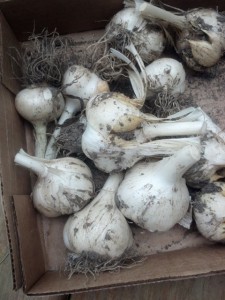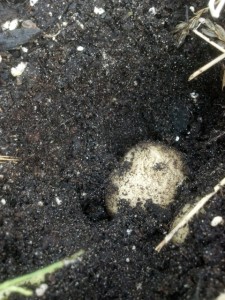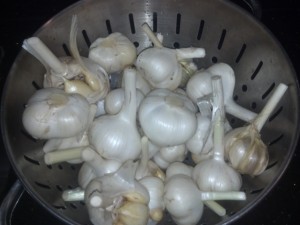Preserving: Pickling, Canning, Dehydrating
Nancy, Nancy, Just How Fancy, Does Your Garden Grow?
The Dream of the Crop
Preserving: Pickling, Canning, Dehydrating
Britt Uecker, Horticulturist and Garden Educator at Grow Benzie
I didn’t grow up learning how to preserve food from my mother. I am self-taught and am living proof that at any age we can learn how to preserve produce all through the season. When I turned my passion of gardening into a career in Horticulture at Michigan State University I began my journey of really discovering the love of produce to it’s fullest dimensions. As the abundance of the farm presented itself I was literally forced to learn how to prepare, eat and then preserve the harvest as it was available. Contrary to some common belief, preserving does not happen at the end of the season, but rather it starts when our first crops come in in late spring and continues throughout.
Michigan is #2 for variety and high in the top 10 producers in the country; we are fortunate to live in such a verdant and beautiful state. If you do not grow enough of your own produce, farmers markets and farm stands are great sources for buying the goods you need. There are many benefits to preserving as produce is made available. When produce is at it’s peak season, it is at it’s absolute freshest, it is most nutritious, it is usually the most inexpensive, and keeps the money in the local economy.
I begin preserving with eating asparagus fresh mostly since it is nearly an 8 week season, and then pickling it. Some folks blanch and freeze it, I do not care for the texture, but it can be used for soups and casseroles. Then strawberry season is upon us, and I make jams, jellies and freeze the topped berries out onto cookie sheets then bag them into freezer bags for many later uses. This can be done with any berry. If it is too hot outside to steam up your kitchen, consider making jam later from your freezer berries when the temperatures become more mild and comfortable. I do something similar with cherries, often going out to a u-pick orchard for the best deal and a family outing. When I pickle, can, or make jams I make enough to last for two years so that I do not have to do every berry or pickle each season. As it is a labor of love.
Cherry season seems to be the 4th of July in the garden kicking off the beginning of the real garden season when everything else really starts to come in! I blanch and freeze most greens and green vegetables rather than canning, and I do enough to last until the next season begins. I calculate how many weeks there are until the next season, figure 1 pound of each vegetable per week and process accordingly. And as the tomatoes are bursting at the seams I have my latest favorite technique for processing them. I core and cut out any imperfection and throw them into freezer bags for dealing with them later, at which point I pile them high in a crock pot or roaster in the morning and let them cook down all day, then puree them (with an immersion blender) skins and all into a lovely almost-paste concentrate. It can then be canned or cooled and put into freezer bags for later use.
My family loves dried fruit, and the bulk of the work is in the pitting of the cherries. Using a mandolin or corer/slicer for apples and pears makes short work of it then laying them out onto the trays for 12-48 hours depending on the fruit. The investment of a good dehydrator can be a once in a lifetime purchase for some healthy snacking. One of my final seasonal duties is making sauerkraut and kimchi; fermented foods are particularly beneficial to our digestive tracts and overall health. I will make tangerine or orange marmalade sometimes in December when the citrus is in season and use it for gifts at Christmas time.
There is nothing like sitting down for a dinner in the middle of winter and pondering the bounty on my plate. It is absolutely possible to eat healthfully and locally all season long, and it is so worth it.
Nancy, Nancy, Just How Fancy, Does Your Garden Grow?
By Nancy Denison, Master Gardener
It wasn’t a fancy garden we inherited with the house but a semi-fenced area on the only flat part of our back yard. Inside the 40x30ft area was a privet hedge, two 25ft rows of thorn-less raspberries, perennials, spring onions, garlic, and three slightly raised beds. I had only experimented (with moderate success) with planting a garden at our home in California but with the help my neighbor, Grace, and the space just waiting for me, I dove in.
In the past 24 years I have added comfrey for the raspberries (as a bee attractor), tarragon, chives, oregano, mint (ugh), sage, lavender, plus the annuals; basil, rosemary, and cilantro. This year I planted cilantro seeds twice with no luck, until a few weeks ago when I put the seeds in small containers and they are coming up nicely. I am able to use the basil most years to make several batches of pesto, which is always a nice treat in the middle of winter. I give away bunches of herbs to friends but there is still more than any one would ever use.
Vegetably speaking…I have experimented with various combos over the years but have found my favorites, and those that grow well, are the lovely zucchini, broccoli, green beans, tomatoes, snap peas, lettuce and for the past few years, kale, beets and carrots. Rhubarb, which came from two different neighbors, is still looking good, though my husband has had enough! Maybe I will try freezing a bunch again for a winter surprise…
As all gardeners know, every year is unique and offers bountiful growth with some plants and some eaten to death by some critter. I have amended the soil for several years with the “lasagna” style of layering leaves, grass clippings, newspaper, and compost which breaks down over winter. Then I also add some good compost to the soil and mix in before planting in the spring.
I have learned to wait till the end of May before planting the young starts of kale, lettuce, broccoli, and tomatoes I get from the TC Farmer’s Market. I have yet to figure out why my bean, snap pea, zucchini seeds don’t germinate well and require multiple plantings before sprouting. I even tried to germinate the seeds this year in paper towels and plastic bags so they might have a better start, but alas, not so helpful. Then sometimes after the new shoots come up, some little visitor munches on the leaves to the point of destruction and I have to start again. I have some success with putting a thin band of aluminum foil around the stem of these little guys or egg shells and coffee grounds, which can deter some undesirables.
Lettuce has been a wonderful producer and I just love being able to pick, clean and eat. It lasts for a long time after being cleaned so we have many homegrown salads from June through almost the end of July. If only the tomatoes were ripe at the same time! I am able to get several cuttings from the broccoli plants which I use for broccoli salad with the large and small heads. Raspberries ripen in early July and are eaten as fast as we can pick. I have frozen them but usually I make a simple raspberry pie which everyone loves. My asparagus plants have been rather slow in producing, even though they are about 4 or 5 years old. This year I did get about 10 spears, though not at the same time, so I’m hoping next year will be even better.
The major pests I have to contend with are slugs and Japanese Beetles…not sure which I detest the most. Of course I pick them off when I can find them or pour salt on them to make sure they don’t find their way back. The beetles wreak havoc on the raspberries, roses and burnette as well as leaving grubs in the yard for spring animal feedings. I discovered a bait trap last year which worked well. This year I set it out early and have greatly diminished the population.
Being intrigued with the growing of potatoes, I decided, last year, to try a “potato tower” that was suggested in a Fine Gardening article. I assembled the chicken wire into a tower and then filled it with straw, and dirt and the starter potatoes in several layers. I had some success with it; however, most of the potatoes were delicious but quite small. So I have tried a different location this year with more sun and at this time both towers are looking good and the potato I just checked on was about three inches in diameter! Much better than last year.
A week ago I harvested the small patch of garlic which came with the garden, getting about 24 heads. I read that when the scapes are cut off on the garlic plants, more energy is sent to the bulb which causes them to grow larger. They are now cleaned and drying. I love how I can use them all year long. I also gathered up the beets that were ready, roasted them and used them in a salad. I even put more seeds in for a second harvest. I used to turn up my nose when it came to eating beets, but I am learning to like them in my old age!
While I await the zucchini and tomato invasion, I will continue to pull weeds, think about what I may have done right and what to do differently for next year…always a learning process, a stretching exercise for the mind and the body and peace for the soul.
The Dream of the Crop
By Jamie Gothard, MG in Training
It happens every year. The innocent dreams of a beautiful vegetable bounty turn into a nightmare featuring a mountain of fresh veggies. They seem to appear overnight and make you question what you were thinking when you innocently planted all of those seeds and small, innocent looking transplants. What in the world can you do about it? There are more answers than you think and some solutions even work best when there is an overabundance of vegetables available so don’t worry, we’ve got you covered.
For starters, the internet has scads of recipes available for you to peruse and even include some that turn your zucchini into noodles, also known as zoodles! Who would have thought it was possible? Recipes such as these not only use your bounty quicker but also reduce calories if you’re into that. One great source is eatlocalgrown.com which includes zoodle recipes like Kung Pao Chicken Zoodles and Zucchini Noodles with Pesto among others. These recipes might be a fun way to use zucchini after zucchini bread has lost its appeal.
Another great valuable source for handling those ever appearing veggies is the Ball Blue Book guide to preserving. The 100th Anniversary Edition features tried and true canning, freezing and dehydrating ideas for fruits, vegetables (from apples to zucchini) and even meats. Not only does this book provide all information needed to figure out how to approach food preservation correctly, it also lists recipe ideas for those preserved food items as well. It is a worthwhile investment as it helps those who are new to food preservation succeed and provides new recipes to some previous editions so that those who are experienced with food preservation may even try new ideas.
Cucumbers are a vegetable with a habit of appearing out of nowhere and all at once. The Ball Blue Book guide has recipes such as dill pickles, relish, and sweet pickle spears. A plethora of cucumber recipes exist as well. For example, allrecipes.com lists 529 cucumber recipes alone so the possibilities seem endless. Several different recipes might come in handy since as soon as the cucumbers are picked and used, another few seem to appear out of nowhere.
Onions can be canned in various recipes and the recommendation from the Michigan State Extension for harvesting onions is to leave them in the ground for one to two weeks after the tops fall over on their own to allow them to develop thick skins. After that time, dig them up and spread them out in a dry, sunny location for three to seven day to allow them to dry before bringing them indoors for storage in a dry, warm location.
Potatoes can be canned as well according to the Ball Blue Book guide. Recipes vary from sweet, white or Irish and can also be frozen. To store them long term, Michigan State Extension recommends waiting until the potato vine dies, the skin is set (meaning it doesn’t peel from the flesh from the application of pressure) and the potato has reached the desired size. Once these indicators have been met, dig them up and cure potatoes starting at around 60 degrees and high humidity for two to three weeks followed by a lower temperature of around 40 degrees.
Squash is separated into two different varieties. Summer squash like zucchini, is harvested when it is immature. Winter squash, on the other hand, is harvested after it matures. Varieties like acorn, spaghetti, butternut and pumpkins all vary with regards to maturation but the rule of thumb provided by Michigan State Extension is to wait until the vines decline and they have been allowed to cure in the field for two to three weeks before harvesting to store.
Tomatoes should be allowed to fully ripen on the vine unless a killing frost prevents this from happening. If they have to be picked green, there are recipes such as fried green tomatoes and The Ball Blue Book guide even provides recipes for canning green tomatoes too. Of course, there are recipes for ripened tomatoes such as sauce, juice and salsa too. Michigan State Extension recommends storing tomatoes at temperatures below 50 degrees because they are sensitive to chilling injury once they have been picked.
The ideas are endless as far as food consumption and preservation is concerned so even when the vegetables start turning from dream into overwhelming nightmare, know that there are many options to consider. If all else fails, just wait until someone leaves their car with the windows down and slip some veggies into their seat while they’re gone. They will probably be thrilled with the gift.
Sources:
Ball Blue Book guide to preserving, 100th Edition
Michigan State University Extension Master Gardener Volunteer Program Training Manual





